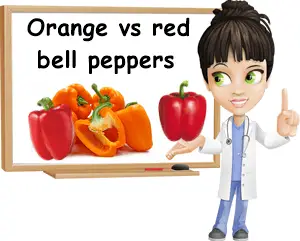Bell peppers, whether green, yellow, orange, red, purple, black or striped, are a healthy food, worth including in almost any diet. Low in calories, fat and carbohydrates, they make a good weight-loss food. Low in sodium, but a good source of dietary potassium, bell peppers are good for high blood pressure. Some colors are particularly high in vitamin C and strengthen the immune system as well as provide anti-aging benefits for the skin by stimulating collagen production. Low-glycemic, they make a great food for blood sugar control. But what do the different colors mean in terms of nutrition and health benefits? Find out below what is the difference between orange and red bell peppers.
Are orange and red bell peppers green first?
Yes, both red and orange bell peppers are initially green. All fruits and vegetables are green first, when unripe. As the ripening process starts, the pigment responsible for the green color, chlorophyll, begins to degrade and allows for the change in color. The degradation of chlorophyll sees the process of fruit ripening and the subsequent change in color.

Are orange bell peppers red bell peppers?
A lot of people believe orange and red bell peppers are the same thing because, apparently, orange bell peppers continue to ripen and change color, turning red in the end. But that’s not true. The two are actually different cultivars, or cultivated varieties, of the same fruit, the bell pepper (scientific name: Capsicum anuum), and have been selected to ripen to different colors: one to orange and one to red. But sure, there are some cultivars that change color multiple times as they ripen. For example, some go from green to purple to black or from green to black to red. Others start green, then turn yellow, then get red stripes – these types of yellow-red bells are known as striped Holland bell peppers because they are said to originate in the Netherlands (two patented, commercially available varieties are Aloha and Enjoya). So yellow, orange, red bell peppers and all the other colors are different color varieties of the same cultivated fruit, but not quite the exact same thing.
Nutrition facts
The difference between bell peppers goes beyond color. All the different colors in our food are not just for aesthetic purposes – each color indicates differences in nutritional status and, consequently, holds important implications for health. Overall, orange and red bell peppers nutrition is fairly similar, although US health authorities have not yet released a nutrition table with nutrition facts for orange bell peppers. Still, the nutritional value of the orange bell pepper is comparable to that of the red in terms of antioxidant content and profile, vitamins and minerals and macro-nutrient content, with only minor differences for some essential nutrients and antioxidants.
Vitamins, minerals and other nutrients in orange and red bell peppers include vitamin A from carotene antioxidants, vitamins B1, B2, B3, B5, B6, B9 and choline, trace amounts of vitamins E and K, calcium, copper, iron, magnesium, manganese, phosphorus, potassium, selenium and zinc. There are also good amounts of dietary fiber, but an overall low energetic value, low carbohydrate and sugar content and extremely low fat and protein values. The two colors have almost no sodium, no vitamin B12 and no vitamin D, but are rich in carotenes such as beta-carotene, xanthophylls such as beta-cryptoxanthin, lutein and zeaxanthin and other polyphenolic antioxidants.

What is the difference?
The biggest difference between the two bell peppers is obvious: color. But here is what that means in terms of nutrition values and health benefits:
- Both colors have the same antioxidant profile and contain both carotene antioxidants such as beta-carotene, alpha-carotene etc. and xanthophyll antioxidants such as lutein, zeaxanthin, beta-cryptoxanthin, alpha-cryptoxanthin etc. Red bell peppers are especially high in carotenes, notably beta-carotene (1624 micrograms per 100 g of fruit), but also xanthophylls such as beta-cryptoxanthin (490 micrograms per 100 g). Versus orange bell peppers which are presumed to have a lower content of both carotenes and xanthophylls, but are still an important dietary source of both types of antioxidant pigments.
Note: Usually, red fruits and vegetables are highest in carotene pigments such as beta-carotene. Carotenes are more commonly responsible for the deep orange and red colors in plants and some animals (and, to a lesser extent, also yellow) and are found in the highest amounts in red plant foods such as red bell peppers and green plant foods such as leafy greens (but the green pigmentation of chlorophyll masks the presence of carotenes). Yellow fruits and vegetables are highest in xanthophyll pigments such as lutein and zeaxanthin. Xanthophylls are more commonly responsible for yellow colors in plant and animal foods and are thus found in high amounts in yellow foods, but also orange, green and red foods.
- Red bell peppers are higher in lycopene than orange ones. Lycopene is a carotene pigment responsible for the color red in foods such as gac fruit, tomatoes, tomato sauce, juice and ketchup, sea buckthorn, goji berries, rosehip fruits, pink grapefruit etc. A serving of 100 g of sauteed red bell peppers has about 480 micrograms of lycopene – cooking foods high in lycopene and eating them with a source of fat makes the antioxidant pigment more bioavailable for absorption and increases its uptake in the body. See more benefits of lycopene.
- Both colors are high in vitamin A as a result of a high beta-carotene content. Carotenes, especially beta-carotene, are absorbed and stored in the human body and converted into vitamin A when needed. A serving of 100 g of raw red bell peppers contains the equivalent of 157 micrograms of vitamin A from carotenoid antioxidants such as beta-carotene. Versus orange bell peppers which have been found to contain 630-900 micrograms of vitamin A per 100 g (the equivalent of 70% – 100% of the recommended daily intake of the vitamin for an average adult), although there are sources that put their vitamin A content much lower, at 63-99 micrograms of vitamin A (the equivalent of 7% or 11% of daily requirements).
- Both colors are good for eyesight, but red bell peppers may be better. This is because they are extremely high in the antioxidant beta-carotene which is converted into vitamin A, so high in vitamin A which is good for eyesight. They are also high in the antioxidant lycopene which has not yet been reported in orange bell peppers. Lycopene holds benefits for vision too, protecting the eyes from damage caused by ultraviolet light. At this point, it would seem that red bell peppers are better for the eyes versus orange, but both colors hold benefits for color vision, night vision, visual acuity as well as provide protection against damage from sunlight and sunlight radiation.
- Depending on the exact shade of orange (lighter or deeper), orange bell pepper antioxidant profile may vary, vs the antioxidant profile of red bell peppers which is more constant since there isn’t really any variation in color. Lighter orange bells may have more of some antioxidant pigments and less of others. For example, a light orange, almost yellow color may mean more yellow xanthophyll antioxidants such as lutein and zeaxanthin and less orange-red carotene antioxidants with vitamin A activity such as beta-carotene and alpha-carotene. But even with this variation, orange fruits are still extremely healthy.
- Another difference between the two colors, except for antioxidant profile and content, is taste: red bell peppers are considerably sweeter versus orange bell peppers which are not as sweet. But both colors have strong non-pungent or non-spicy peppery flavors and a pleasantly crisp, thick, meaty flesh.
Until more information on the nutrition of orange bell peppers becomes available (at which point the article will be updated), this pretty much covers the differences between the two fruit colors. As for similarities, both colors are good sources of manganese and potassium, providing an estimated 5% of daily requirements of each mineral and subsequent benefits such as contributing to the body’s antioxidant defense system, providing benefits for bones and helping lower high blood pressure. Both colors are low in most other dietary minerals as well as low in vitamins E and K and several B vitamins, but good sources of vitamins B3 and B6 and even better sources of vitamin C. There is no vitamin D and no vitamin B12 in either color.
